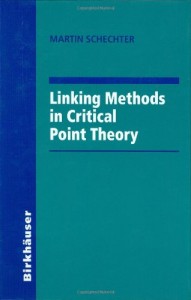Many non-linear problems in the physical and social sciences can be reduced to finding critical points (minima, maxima, and minimax points) of functionals (real-valued functions on various spaces). Much of the activity in the calculus of variations is devoted to finding such points, although a more difficult problem is finding critical points that are neither maxima nor minima. Until recently there was no organized procedure for producing such points. In this work, Schechter briefly reviews the issue of critical points from the old 'linking' viewpoint and then studies the theory in light of a new concept of 'linking subsets' which he helped introduce. New theorems are proved and applied to the solution of subcritical problems on bounded domains. This monograph is aimed at researchers and graduate students interested in the study of critical point theory as applied to boundary value problems. There are good examples interspersed throughout this clear exposition, which combined with a thorough bibliography of the recent literature and index, make this a useful resource for self-study. Contents: Foreword 1. Critical Point Theory Introduction Other Geometries Semilinear Boundary Value Problems The Critical Point Alternative Estimates on Eigenspaces Asymptotic Limits Types of Resonance Multiple Solutions Eigenvalues 2. Linking The Basic Concept The Flow Weaker Conditions Another Form Some Consequences Examples of Linking Critical Sequences The Compact Case A Sandwich Theorem Appendix I: Pseudo-Gradients Appendix II: Differential Equations 3. Semilinear Boundary Value Problems Introduction Mountain Pass Geometry Finding a Critical Sequence Obtaining a Solution Solving the Problem Resonance Appendix I: The Sobolev Inequality 4. Alternative Methods Introduction The Saddle Point Alternative An Alternative Form Some Corollaries An Application Superlinear Problems Some Modifications 5. Bounded Saddle Point Methods Introduction A Bounded Mountain Pass Lemma A Compactness Condition Dual Situations Combined Results Nonlinear Eigenvalues Double Resonance Appendix I: Generalized Pseudo-Gradients 6. Estimates on Subspaces Introduction Some Important Quantities The Estimates Nontrivial Solutions A Variation 7. The Fucik Spectrum Introduction Jumping Nonlinearities Quantities Related to the Fucik Spectrum Applications 8. Resonance Introduction More on Double Resonance Resonance Involving Many Eigenvalues Landesman-Lazer Resonance Equal Limits at Infinity Nonvanishing Solutions Unequal Limits at Infinity 9. Boundary Conditions Introduction Bounded Linking Reverse Boundary Conditions An Application Sufficient Conditions 10. Multiple Solutions Introduction The Abstract Theory Some Applications Additional Solutions 11. Nonlinear Eigenvalues Introduction The Hampwile Theorem Applications 12. Strong Resonance Introduction Simple Solutions A Different Approach Resonance at the First Eigenvalue Additional Solutions 13. Notes, Remarks and References Bibliography Index
Linking methods in critical point theory
Sobre
Talvez você seja redirecionado para outro site












